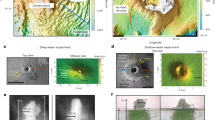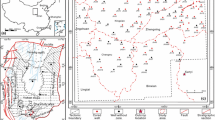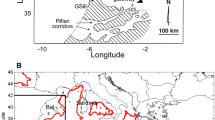Abstract
Facies bodies in geostatistical models of deep-water depositional environments generally represent channel-levee-overbank-lobe morphologies. Such models adequately capture one set of the erosional and depositional processes resulting from turbidity currents traveling downslope to the ocean basin floor. However, depositional morphologies diverge from the straight forward channel-levee-overbank-lobe paradigm when the topography of the slope or the shape of the basin impacts the timing and magnitude of turbidity current deposition. Subaqueous mass-transport-deposits (MTDs) present the need for an exception to the channel-levee-overbank-lobe archetype. Irregular surface topography of subaqueous MTDs can play a primary role in controlling sand deposition from turbidity currents. MTD topography creates mini-basins in which sand accumulates in irregularly-shaped deposits. These accumulations are difficult to laterally correlate using well-log data due to their variable and unpredictable shape and size. Prediction is further complicated because sandstone bodies typical of this setting are difficult to resolve in seismic-reflection data. An event-based model is presented, called DFTopoSim, which simulates debris flows and turbidity currents. The accommodation space on top of and between debris flow lobes is filled in by sand from turbidity currents. When applied to a subsurface case in the Molasse Basin of Upper Austria, DFTopoSim predicts sand packages consistent with observations from core, well, and seismic data and the interpretation of the sedimentologic processes. DFTopoSim expands the set of available geostatistical deep-water depositional models beyond the standard channel-levee-overbank-lobe model.









Similar content being viewed by others
References
Armitage DA, Romans BW, Covault JA, Graham SA (2009) The influence of mass transport deposit topography on the evolution of turbidite architecture: the Sierra Contreras, Tres Pasos formation (Cretaceous), Southern Chile. J Sediment Res 5:287–301
Arpat GB, Caers J (2007) Conditional simulation with patterns. Math Geol 39(2):177–203
Avseth P, Mukerji T, Mavko G (2005) Quantitative seismic interpretation: applying rock physics tools to reduce interpretation risk. Cambridge University Press, Cambridge, 359 pp
Bernhardt A, Stright L, Lowe DR (2012) Channelized debris-flow deposits and their impact on turbidity currents: the Puchkirchen axial channel belt in the Austrian Molasse Basin. Sedimentology 59(7):2042–2070
Boucher A (2009) A flexible and expandable design to generate training images for sedimentary environment. In: Proceedings sediment body geometry and heterogeneity: analogue studies for modelling the subsurface. The Geological Society, Burlington House, Piccadilly, London
Caers J, Strebelle S, Payrazyan K (2003) Interpreter’s corner—stochastic integration of seismic data and geologic scenarios: a West Africa submarine channel saga. Lead Edge 22(3):192–196
De Ruig MJ, Hubbard SM (2006) Seismic facies and reservoir characteristics of a deep-marine channel belt in the Molasse foreland basin, Puchkirchen formation, Austria. Am Assoc Pet Geol Bull 90(5):735–752
Garziglia S, Migeon S, Ducassou E, Loncke L, Mascle J (2008) Mass-transport deposits on the Rosetta province (NW Nile deep-sea turbidite system, Egyptian margin): characteristics, distribution, and potential causal processes. Mar Geol 250(3–4):180–198
Goovaerts P (1997) Geostatistics for natural resources evaluation. Applied geostatistics series. Oxford University Press, London, 483 pp
Griffiths CM, Dyt C, Paraschivoiu E, Liu K (2001) SEDSIM in hydrocarbon exploration. In: Merriam D, Davis JC (eds) Geologic modeling and simulation. Kluwer Academic, New York, pp 71–97
Hampton MA, Lee HJ, Locat J (1996) Submarine landslides. Rev Geophys 34(1):33
HOT Engineering (2007) Puchkirchen: near field exploration study, Leoben, Austria. HOT Eengineering consulting report, 50 pp
Hubbard SM, Graham SA, De Ruig MJ (2009) Confined channel-levee complex development in an elongate depo-center: deep-water Tertiary strata of the Austrian Molasse Basin. Mar Petroleum Geol 26(1):85–112
Jackson CA, Johnson HD (2009) Sustained turbidity currents and their interaction with debrite-related topography; Labuan Island, offshore NW Borneo, Malaysia. Sediment Geol 219(1–4):77–96
Labourdette R (2007) Integrated three-dimensional modeling approach of stacked turbidite channels. Am Assoc Pet Geol Bull 91(11):1603–1618
Larue D, Hovadik J (2006) Connectivity of channelized reservoirs: a modelling approach. Pet Geosci 12(4):291–308
Liu Y, Harding A, Abriel W, Strebelle S (2004) Multiple-point simulation integrating wells, three-dimensional seismic data, and geology. Am Assoc Pet Geol Bull 88(7):905–921
McHargue T, Pyrcz M, Sullivan MD, Clark J, Fildani A, Romans B, Covault J, Levy M, Posamentier H, Drinkwater N (2010) Architecture of turbidite channel systems on the continental slope: patterns and predictions. Mar Petroleum Geol 28(3):1–16
Moscardelli L, Wood L (2008) New classification system for mass transport complexes in offshore Trinidad. Basin Res 20(1):73–98
Normark WR, Mcgann M, Sliter R (2004) Age of Palos Verdes submarine debris avalanche, Southern California. Mar Geol 203(3–4):247–259
Pickering KT, Corregidor J (2005) Mass-transport complexes (MTCs) and tectonic control on basin-floor submarine fans, Middle Eocene, South Spanish Pyrenees. J Sediment Res 75(5):761–783
Polyakova EI, Journel AG (2007) The Nu expression for probabilistic data integration. Math Geol 39(8):715–733
Pyrcz MJ, Boisvert JB, Deutsch CV (2008) A library of training images for fluvial and deepwater reservoirs and associated code. Comput Geosci 34(5):542–560
Pyrcz MJ, Boisvert J, Deutsch CV (2009) ALLUVSIM: a conditional event-based fluvial model. Comput Geosci 35(8):1671–1685
Pyrcz MJ, Catuneanu O, Deutsch CV (2005) Stochastic surface-based modeling of turbidite lobes. Am Assoc Pet Geol Bull 89(2):177–191
Pyrcz MJ, McHargue T, Clark J, Strebelle A, Sullivan M (2012) Event-based geostatistical modeling: description and applications. In: 2012 geostatistical congress, Oslo, Norway
Remy N, Boucher A, Wu J (2009) Applied geostatistics with SGeMS: a user’s guide. Cambridge University Press, Cambridge
Russell B, Hampson D, Bankhead B (2006) An inversion primer, CSEG Recorder Special Edition(1):96–103
Shultz MR, Fildani A, Cope TD, Graham SA (2005) Deposition and stratigraphic architecture of an outcropping ancient slope system: Tres Pasos formation, Magallanes Basin, Southern Chile. Geol Soc London Spec Pub 244(1):27
Stoyan D, Kendall WS, Mecke J (1987) Stochastic geometry and its applications. Wiley, New York, 345 pp
Strebelle S (2002) Conditional simulation of complex geological structures using multiple-point statistics. Math Geol 43(1):1–22
Stright L, Bernhardt A, Mukerji T, Boucher A, Derksen R (2009) Revisiting the use of seismic attributes as soft data for sub-seismic facies prediction: proportions versus probabilities. Lead Edge 28(12):1460–1468
Sylvester Z, Pirmez C, Cantelli A (2010) A model of submarine channel-levee evolution based on channel trajectories: implications for stratigraphic architecture. Mar Petroleum Geol 28(3):1–12
Takahashi I (2000) Quantifying information and uncertainty of rock property estimation from seismic data. Ph.D. thesis, Stanford University, Stanford, 208 pp
Wellner R, Beaubouef R, Van Wagoner J, Roberts H, Sun T (2005) Jet-plume depositional bodies—the primary building blocks of Wax Lake Delta. GCAGS Trans 55:867–909
Widess M (1973) How thin is a thin bed? Geophysics 38(6):1176–1180
Zhang T, Switzer P, Journel AG (2006) Filter-based classification of training image patterns for spatial simulation. Math Geol 38(1):63–80
Zhang X, Pyrcz MJ, Deutsch C (2009) Stochastic surface modeling of deepwater depositional systems for improved reservoir models. J Pet Sci Eng 68(1–2):118–134
Acknowledgements
We would like to thank Dr. Craig Dietrich for donating extensive time to a thorough edit of this paper. Also, we would like to thank Rohöl-Aufsuchungs A.G. (RAG) for financial and logistical support of our research, as well as for permission to publish their data in this study. In particular, we wish to thank Richard Derksen for his ongoing support of this research. This work has benefited greatly from discussion on petroleum geology and sedimentology with Stephan Graham, Donald Lowe, and Stephen Hubbard, rock physics and seismic data interpretation with Tapan Mukerji and Gary Mavko, and geostatistical modeling with Andre Journel. We also acknowledge generous software donations from Schlumberger (Petrel) and the inversion models produced by HOT Engineering in 2007 using Hampson-Russel. Finally, valuable feedback and support has been provided by the Stanford Project on Deepwater Depositional Systems (SPODDS), an industrial affiliates program whose members include Aera Energy, Anadarko Petroleum Corporation, BHP Billiton, Chevron, ConocoPhillips, Hess Corporation, Marathon Oil Company, Nexen Energy, Occidental Petroleum, Petrobras, Reliance Industries Ltd., Rohöl-Aufsuchungs A.G. (RAG), Schlumberger, and Shell.
Author information
Authors and Affiliations
Corresponding author
Rights and permissions
About this article
Cite this article
Stright, L., Bernhardt, A. & Boucher, A. DFTopoSim: Modeling Topographically-Controlled Deposition of Subseismic Scale Sandstone Packages Within a Mass Transport Dominated Deep-Water Channel Belt. Math Geosci 45, 277–296 (2013). https://doi.org/10.1007/s11004-013-9444-7
Received:
Accepted:
Published:
Issue Date:
DOI: https://doi.org/10.1007/s11004-013-9444-7




